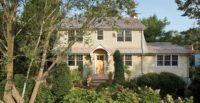Opening seamlessly to the trees of a former estate, this 5,300-square-foot country home reflects a Manhattan family’s desire for a luxurious—yet unpretentious—raw and comfortable retreat. The designer started the project by weaving a rescued 19th-century barn frame into existing 1980s structures, setting the stage for a richly textured material palette that would translate the old and the reclaimed into a new and modern language.
Design concept and solution: Discovering a demolition threatened New Jersey barn close in size to the retained portion of the existing house on the Amagansett property was this project’s first step. In the fashion of an archeological preservation, the barn’s frame was dismantled, cleaned, and repaired by the New Jersey Barn Company in preparation to be re-erected at the new site. Then, it was placed on a new foundation and assembled with only wooden pegs. In preparation to receive the barn, the property’s original 1980’s house was scaled back down to its main gabled structure, removing several bland additions. The iconic gabled forms of the new barn structure and the existing structures sit apart and at 90 degrees to one another, and are characterized by different sized openings. The glass and steel enclosure of the kitchen was conceived as the “connective tissue” to join the two structures and orient the inhabitants to the surrounding landscape.
These two halves’ interiors provide distinct spatial experiences. The barn, with its soaring 20-foot high ceiling, is the main living area. The existing structure became home to the more private spaces, and laundry, storage, and powder room are articulated in a central “box.” Adjacent to the spacious common areas are gemuetlich corners—cozy and intimate with separate garden views. The house is unified by repeated details and a simple palette of few materials—concrete, reclaimed wood, patinated steel, aluminum, and limestone. The furnishings were considered simultaneously with the architecture and include an eclectic mix of handpicked industrial, American vernacular, Scandinavian, and mid-century modern artifacts.
When planning the additions, great care was taken not to disturb the existing garden, but to carefully extend the structure to a comfortable size. Thus, the house opens towards the old garden, large doors lead to generous terraces, and most rooms extend into the surrounding landscape. High-maintenance, non-native shrubs were replaced with native species such as flowering dogwood, hemlocks, ferns, and American holly.
In addition to the enveloping, lush comfort, sustainability was also a consideration. The family maintains low energy costs because the designer prioritized natural ventilation, was strategic about window placement, and utilized a geothermal water-to-air heat-pump system for heating and cooling. The resulting house contrasts raw with machined elements and vernacular with modern to create a relaxed, unpretentious house.
PeopleOwner: Withheld
Completion Date: September 2009
Gross square footage: 5300 sq.ft.
Total construction cost: Withheld
Designer: Alex Scott Porter Design Personnel in architect's firm who should receive special credit: Project Team: Jenni Dang, Stefan Eilmsteiner, Carl Mahaney
Architect of record: John Beringer
Interior designer: Alex Scott Porter Design
Engineer(s): Structural Engineer:
Consultant(s): Landscape:
General contractor: Don Matheson LLC
Photographer(s): Photo © Tim Street-Porter
Renderer(s): Drawings by Prae Lorvidhaya |
ProductsBarn Salvage/Restoration The New Jersey Barn Company
Exterior cladding Wood: Wood Windows: Aluminum Windows: Glazing: Custom Wood doors: Locksets: Cabinetwork and custom woodwork: Wood Finishes: Concrete Countertops and Bath Fixtures: |































































